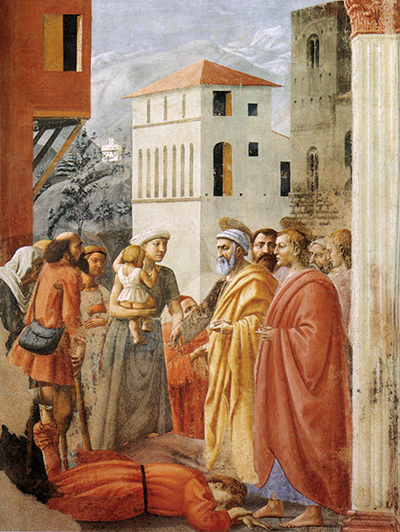The use of bright colours illustrated through Renaissance artist Masaccio's artwork is the foundation of the artistÕs popularity.
The artist is well known as the founding artist who began the classic art period known as the Renaissance Era.
The plot behind the artwork showcases a quarrel in a city as members gather on the street. Arrays of different characters fill the canvas as each holds their own personality that adds to the artwork. While the focal point of the painting falls upon the individuals that gather on the street, the viewer is quick to notice the man on the floor.
While the male figure seems as if he is dead, his right leg is bender in the air suggesting that he is alive. The scene holds a mysterious feel as the viewer wonders what had occurred for the man to fall to the floor. Alongside, why the man remains on the floor rather than getting up and part taking in the quarrel. It is strongly suggested that the man is hurt, however no glimpse of blood is showcased on his body.
The significant characters within the scene are the holy figures that stand near the centre right of the canvas. The artist had painted a golden aurora around their heads to illustrate their holy presence. The main one of these two Saints is the one to the left of the artwork as Masaccio had portrayed him with a captivating white beard. The artist had paired this characteristic with a similarly coloured grey and white hat.
Masaccio highlighted this figure by displaying his clothing in a light yellow colour, differing from the other characters who hold textiles in shades of orange. The artist had commonly depicted these scenes of people gathering as illustrated in his previous artwork Baptism of Neophytes. Both illustrate focal characters with background figures adding to the confusion and mystery of the art.
Within the Distribution of Alms and Death of Albanias, an array of scenes unfolds within the painting. A woman is placed in the centre as she holds on to a small child within her arms as she extends her arm towards the prominent Saint. Behind the woman a man kneels as he places his hands together in a begging position.
A man to the left of the woman holds onto a crutch as he bends his leg as if it is broken. His balding head progresses into thick locks as similarly illustrated in his beard. All of these different figures add an interesting context to the artwork as the viewer wonders about the exact events that are portrayed within the painting.
The rich background accentuates the beautiful setting of the scene that the artist depicts, set in Italy. A real white building stands near the centre of the piece as it is detailed with a peach roof and columns within the arches and doorways. To the right of the building, a tall brick mansion stands similar to a historic palace. A glimpse of a burnt orange building is showcased at the left of the painting, as the artist depicts three structures.
Grey skies fill the background of the artwork as the artist creates an altered presence in the work through the natural environment. The full skies suggest a shift in session illustrated through the painting as the city members gather to discuss change.




